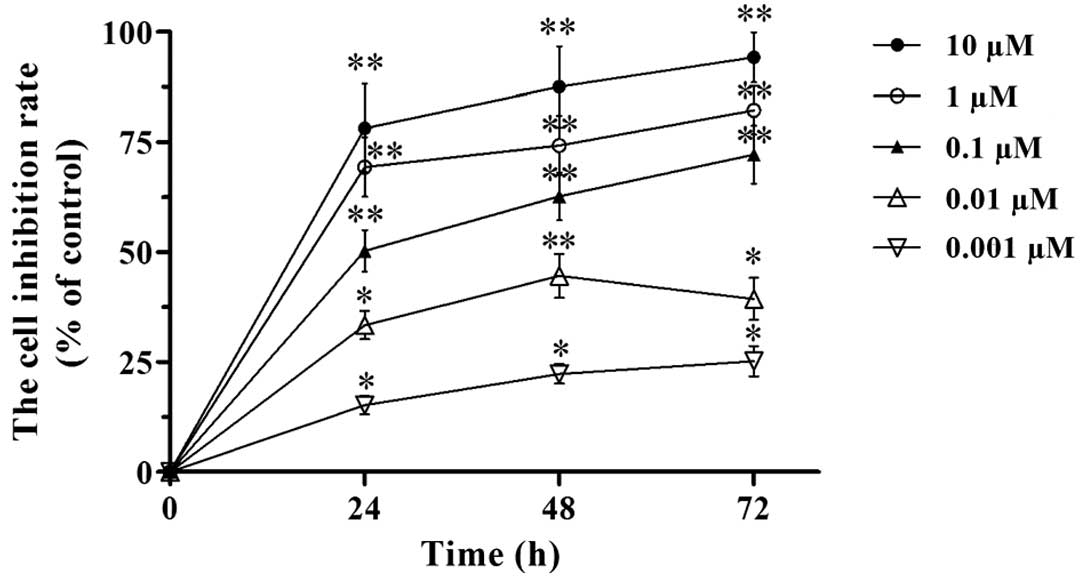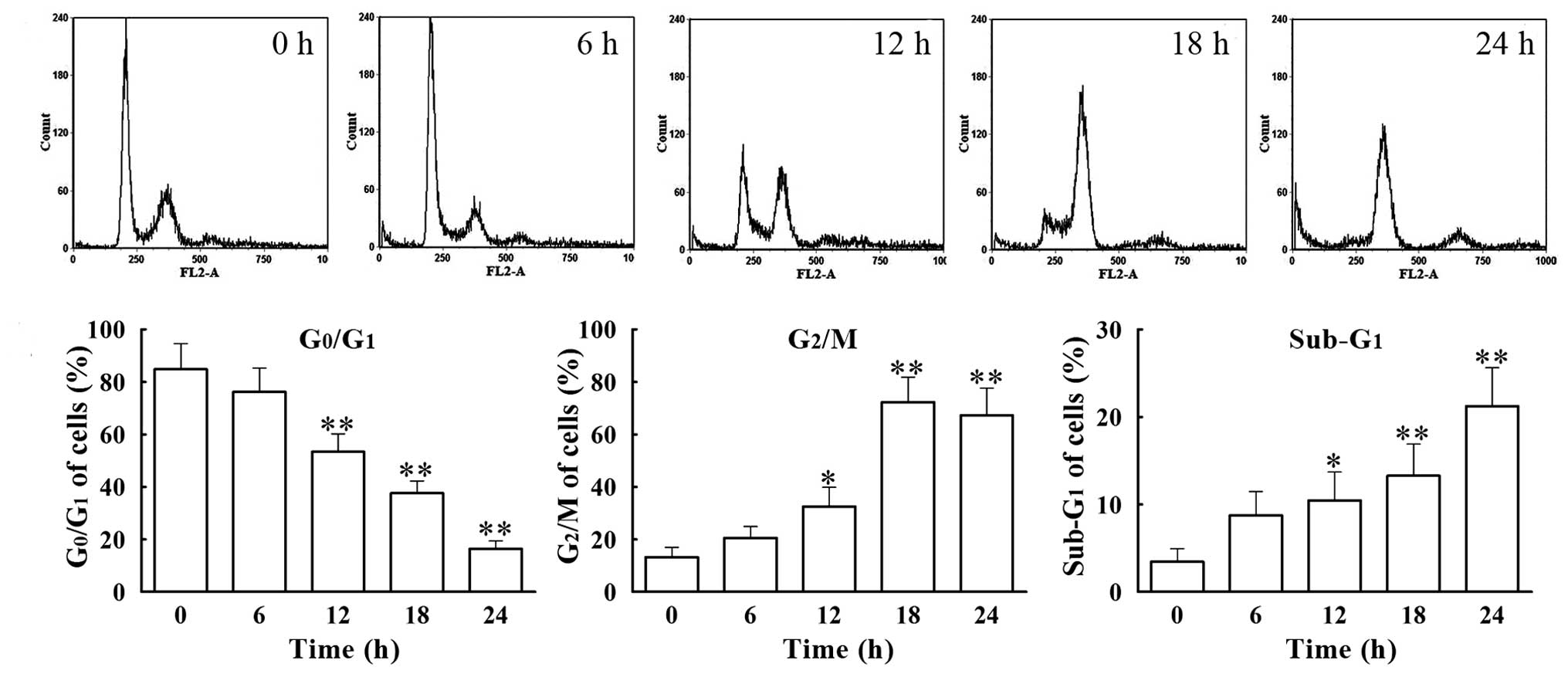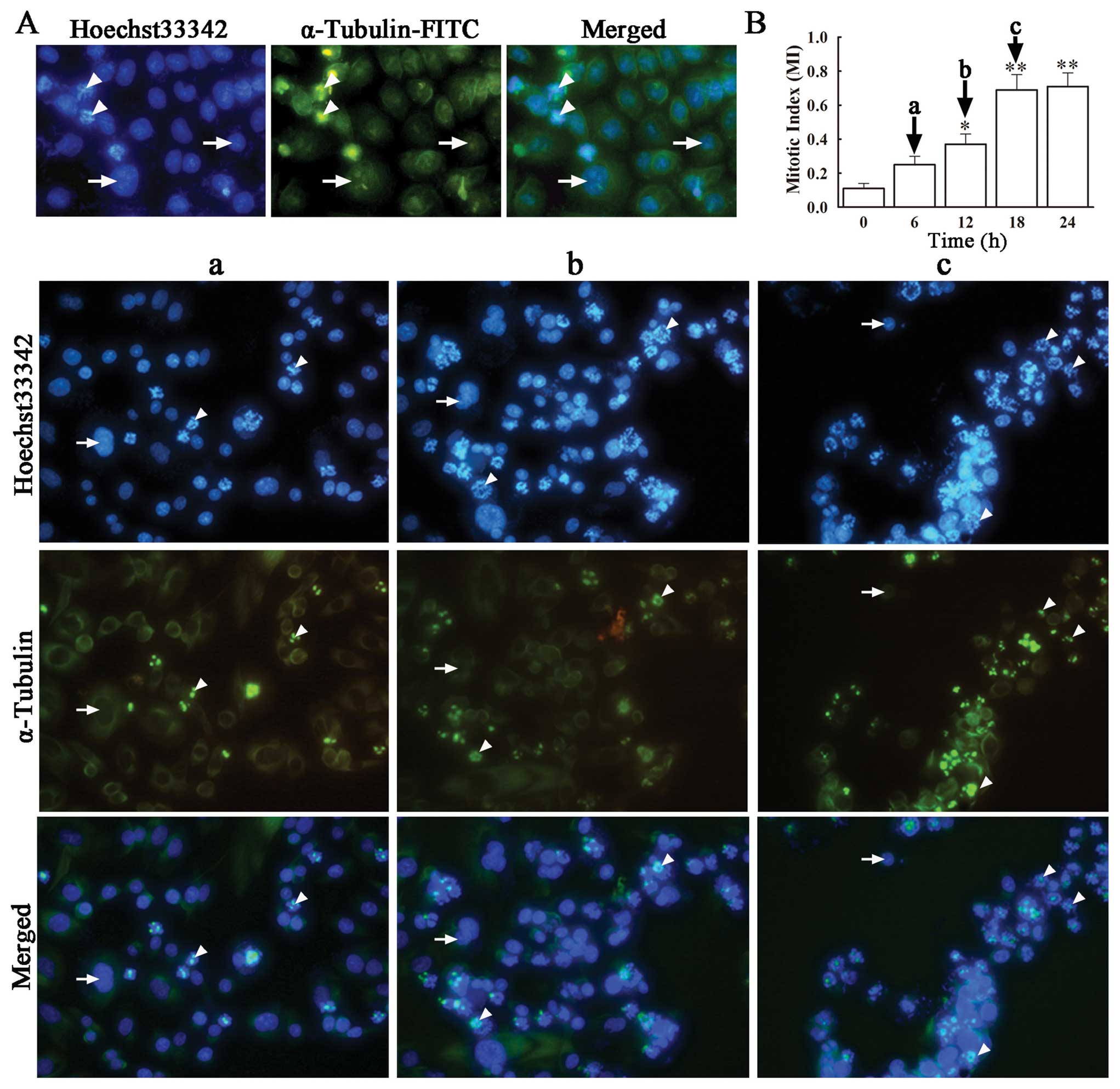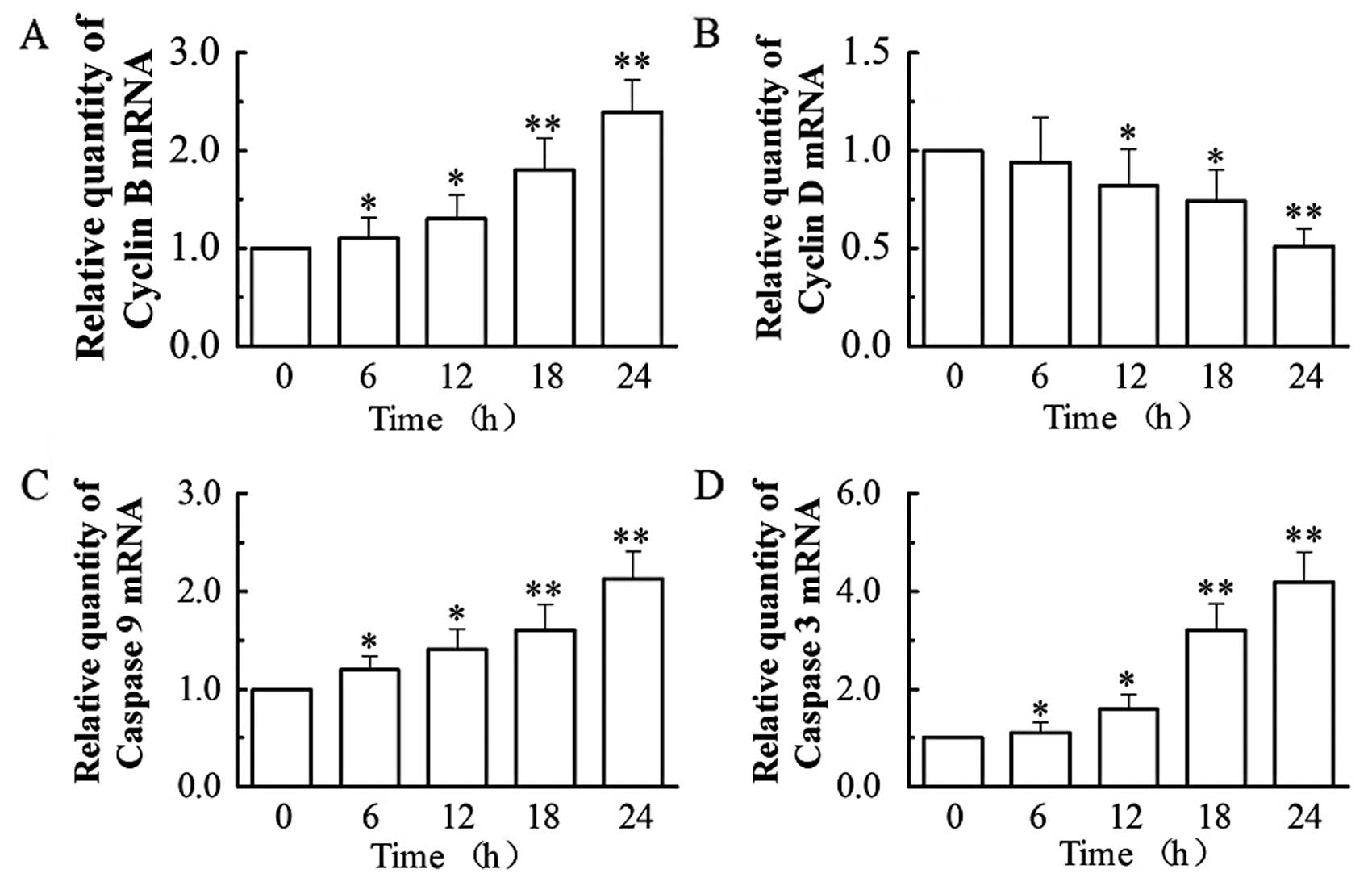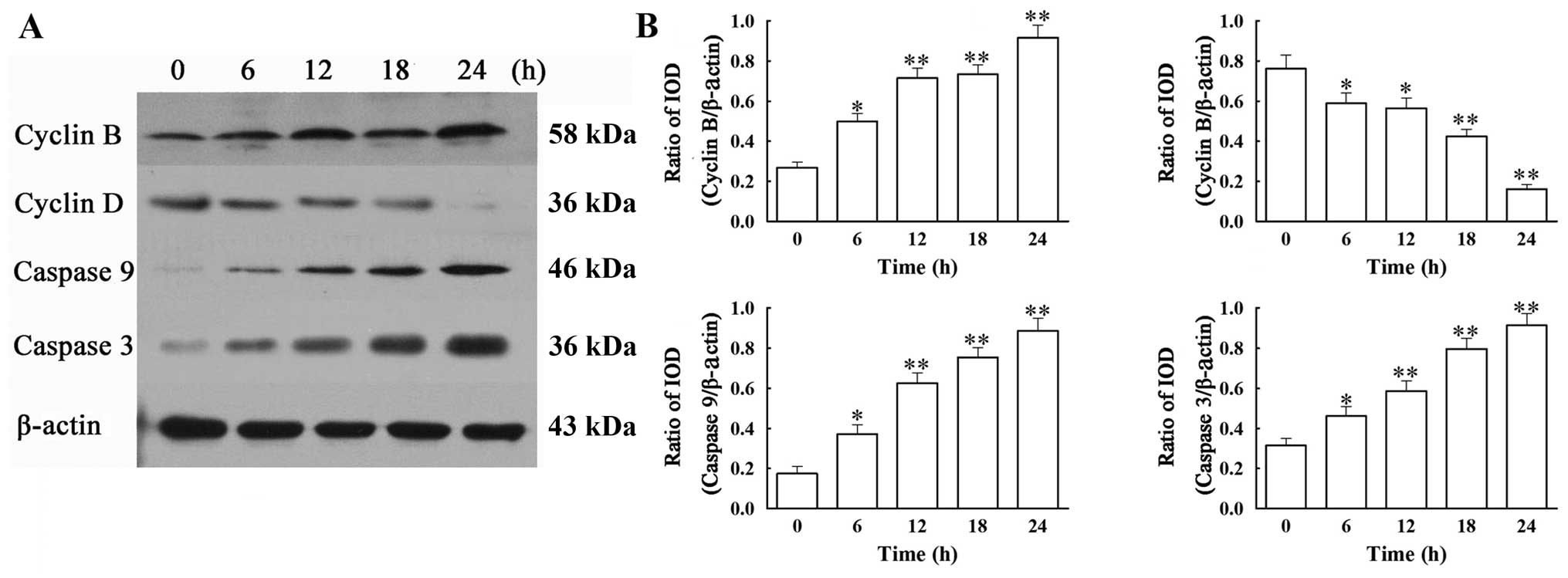Vincristine induces cell cycle arrest and apoptosis in SH-SY5Y human neuroblastoma cells
- Authors:
- Published online on: October 30, 2012 https://doi.org/10.3892/ijmm.2012.1167
- Pages: 113-119
Abstract
Introduction
Neuroblastoma is a type of solid tumor that commonly occurs in children under 5 years of age, with a current prevalence of 1 out of 100,000 children (1). The clinical hallmark of neuroblastoma is its heterogeneity (2). It most commonly originates from one of the adrenal glands but it can also develop in the nerve tissues located in the neck, chest, abdomen and pelvis (2). Common treatments for neuroblastoma include intensive chemotherapy, surgery, radiotherapy, stem cell transplantation and immunotherapy (3–5). Low-risk patients can be cured via surgery, while intermediate and high-risk patients require intensive chemotherapy and/or other treatments (4). Vincristine (VCR), an alkaloid extracted from Catharanthus roseus, is frequently used in combination chemotherapy (6). For example, VCR is used together with topotecan for the treatment of advanced bilateral intraocular retinoblastoma (7). It is also used together with carboplatin for the treatment of children with newly diagnosed progressive low-grade gliomas (8).
In contrast to normal somatic cells, cancer cells exhibit an uncontrolled cell cycle and decreased apoptosis (9). Most chemotherapeutic agents used in the clinic target those two features of cancer cells, inducing their cell cycle arrest and apoptosis. For example, it has been demonstrated that combined treatment with VCR and cisplatin, another commonly used anticancer agent, induced apoptosis of the human retinoblastoma cell lines Y79 and WERI-Rb1, in a dose-dependent manner (10). In acute lymphoblastic leukemia cells, VCR induced apoptosis through activation of caspase-3 and -9 (11). Other anticancer drugs such as baicalein led to cell cycle arrest at the S phase by downregulating cell cycle factors including CDK-4, cyclin B1 and D1 in human lung squamous carcinoma CH27 cells (12). Similarly, VCR, as an anti-tubulin compound, can also lead to cell cycle arrest at the G2/M phase by promoting microtubule depolymerization in many tumor cell lines (13). However, despite the studies demonstrating the anti-tubulin and apoptotic effect of VCR on cancer cells, the mechanism involved in the VCR-induced cell death in neuroblastoma cells is still not clear. Consequently, the application of VCR in chemotherapies, for neuroblastoma and lymphoma, still requires a high dosage resulting in high toxicity (14,15).
The SH-SY5Y cell line originates from human neuroblastoma. It contains many features representing dopaminergic neurons (16). SH-SY5Y cells can also be induced to differentiate into mature neurons (16), which exhibit a distinct morphology and are easily detected (16). Therefore, in the present study we used the SH-SY5Y cell line to analyze the impact of VCR on the cell cycle and changes in apoptosis. We also investigated the expression of apoptotic and cell cycle-related factors following VCR treatment. We aimed to clarify the mechanisms involved in the anticancer function of VCR and provide important references for VCR application in neuroblastoma chemotherapy.
Materials and methods
Cell culture
The human neuroblastoma cell line SH-SY5Y was purchased from the China Center for Type Culture Collection. Cells were cultured in H-DMEM medium containing 10% FBS at 37°C with 5% CO2.
MTT assay measurement of cell proliferation
SH-SY5Y cells at a logarithmic phase were seeded in 96-well plates (at 2×106/l) and incubated for 12 h until cells formed a monolayer. Wells were randomly chosen for treatment groups and a control group. For the treatment groups, cells were incubated with 200 μl of cell culture medium containing 0.001, 0.01, 0.1, 1 or 10 μM of VCR (Sigma-Aldrich, St. Louis, MO, USA). In the control group, cells were grown in 200 μl cell culture medium only. Cells were incubated for another 24, 48 and 72 h and then 20 μl of 5 g/l MTT (0.1 mg/l final concentration) was added to each well. After 4 h of incubation, the cell culture supernatant was removed, 150 μl of DMSO was added to each well and the plate was shaken for 10 min. The absorbance of each well was detected at 490 nm (A value) on an ELISA plate reader. The growth inhibition rate of VCR-treated cells was calculated as: Growth inhibition rate % = [(average A value of control group - average A value of VCR-treated group)/average A value of control group] × 100%. This experiment was performed in triplicates.
Flow cytometric measurement of the cell cycle distribution
SH-SY5Y cells were seeded in 6-well plates (at 2×106/ml) and incubated for 24 h until they were treated with 0.1 μM VCR for 6, 12, 18 and 24 h. Non-treated cells at 0 h were used as the control group. Cells were washed twice with ice-cold PBS and fixed with 70% ice-cold ethanol. After centrifugation, 100 mg/l RNase and 5 g/l propidium iodide (both purchased from Sigma-Aldrich) were added to each tube, and cells were stained in the dark for 30 min. Detection of cell cycle distribution was then performed on a BD FACSCalibur. FCS Express Version 3.0 software was used to analyze the data.
Immunofluorescent staining measurement of the mitotic index and apoptosis
SH-SY5Y cells were grown on coverslips inside the wells of 6-well plates and were treated with 0.1 μM VCR for 6, 12, 18 and 24 h. Non-treated cells at 0 h were used as the control group. Cells were incubated in warm PHEM solution at 37°C for 1 min, permeabilized with 0.1% Triton X-100 for 1 min and fixed with 3.7% formaldehyde for 15 min at 37°C. Cells were then washed in PBS and stained for 20 min with 20 μl of Hoechst 33342 (final concentration: 10 g/l; Sigma-Aldrich). After washing with TBST, cells were incubated with FITC-labeled anti-α-tubulin antibody (1:50 dilution; Sigma-Aldrich) for 1 h at 37°C. After another TBST wash, fluorescent mounting media were added and the slides were sealed. Under a fluorescence microscope, chromatin agglutination, the number of mitotic cells and the number of apoptotic cells were detected or calculated using Image-Pro Plus 6.0 software. On each slide, 5 fields were chosen randomly, and the number of mitotic cells was counted. The mitotic index (MI) was calculated using the following equation: MI = number of mitotic cells/total number of cells (17–19).
Real-time (RT)-PCR measurement of caspase-3 and -9, cyclin B and D mRNA expression
Cells were seeded and treated as described previously. Total RNA was extracted using the TRIzol reagent (Invitrogen Life Technologies, Carlsbad, CA, USA) and cDNA was synthesized using the PrimeScript™ RT kit (TransGen Biotech, Beijing, China) according to the respective manufacturers' instructions. The primers used in the RT-PCR reactions are listed in Table I. The total reaction volume was 20 μl including 1 μl forward primer, 1 μl reverse primer, 1 μl cDNA, 4 μl SYBR-Green PCR master mix (Roche Diagnostics Corporation, Roche Applied Science, Basel, Switzerland) and 13 μl ddH2O. The following program was used in all reactions: step 1, 1 cycle at 95°C for 10 min; step 2, 45 cycles of 94°C for 10 sec, 60°C for 15 sec and 72°C for 15 sec. Fluorescence signal was collected at each cycle in step 2. All RT-PCR reactions were performed in triplicates. Data were analyzed according to the instruction manual of the Roche LightCycler 2.0 detection system. First, ΔCt = CtGene - CtGAPDH. Then, ΔΔCt = ΔCt treated - ΔCt control. Lastly, 2−ΔΔCt was calculated as the relative mRNA expression of the target genes.
Western blot detection of caspase-3 and -9, cyclin B and D protein expression
Cells were seeded and treated as described previously. Cells were washed twice in PBS and lysed in lysis buffer [50 mM Tris-HCl (pH 7.4); 150 mM NaCl; 1 mM ethylene diamine tetra-acetic acid (EDTA); 5% (v/v) β-mercaptoethanol; 1% Nonidet P (NP)−40; 0.25% sodio deoxycholate; 5 μg/ml leupeptin; 5 μg/ml aprotinin; 0.2 mM phenylmethyl sulfonyl fluoride (PMSF)] and incubated on ice for 60 min. Cell lysates were centrifuged at 12,000 × g, the supernatants were collected and the protein concentration was measured. Protein (50 μg) was loaded from each sample on SDS-PAGE using a 12% running gel. Separated proteins were then transferred to PVDF membranes and blocked with 5% skim milk for 2 h at 37°C. Blots were then incubated with primary antibodies (all rabbit IgG) against caspase-3 and -9 (both at a 1:1,000 dilution; purchased from Epitomics, Burlingame, CA, USA), cyclin B (1:50 dilution), cyclin D (1:200 dilution; both purchased from Thermo Fisher Scientific, Fremont, CA, USA) or β-actin (1:200 dilution; Santa Cruz Biotechnology, Inc., Santa Cruz, CA, USA) overnight at 4°C. After washing in TBST for 3×15 min, the blots were incubated with HRP-labeled rabbit IgG (1:4,000 dilution; KPL, Gaithersburg, MD, USA) for 2 h at 37°C. They were washed again in TBST for 3×15 min, exposed and developed to X-ray films. BandScan 5.0 software was used for protein densitometry measurements (A value).
Statistical analysis
The SPSS 13.0 software was used for data analysis. The t-test was used in the comparison between 2 groups and one-way ANOVA in the comparison between more groups. Results are presented as means ± SE. P<0.05 was considered to indicate a significant difference.
Results
VCR inhibits the proliferation of SH-SY5Y cells
We investigated the impact of VCR on SH-SY5Y cell proliferation by the MTT assay. Our results revealed that VCR inhibited the proliferation of SH-SY5Y cells (Fig. 1). The inhibitory effect increased with the dose of VCR (from 0.001 to 10 μM). Under the same VCR dose, the inhibitory effect on cell proliferation increased with the time of treatment (24, 48 and 72 h time points). Hence, the inhibition of SH-SY5Y cell proliferation by VCR was dose- and time-dependent. According to the MTT assay, the IC50 of VCR in SH-SY5Y cells was 0.113±0.012, 0.078±0.009 and 0.051±0.008 μM at 24, 48 and 72 h, respectively. We therefore chose 0.1 μM of VCR as the treatment dose in the following experiments.
VCR induces SH-SY5Y cell cycle arrest at the G2/M phase
We analyzed the cell cycle distribution of VCR-treated SH-SY5Y cells by flow cytometry. Cells were treated with 0.1 μM of VCR for 6, 12, 18 and 24 h. The percentage of G0/G1 phase cells decreased gradually with time, from 76.26±9.05% at 6 h to 16.46±2.99% at 24 h, with that of the group treated for 24 h being significantly lower (P<0.01) than that in the control group (84.83 ±9.72%) (Fig. 2). Concomitantly, the percentage of G2/M phase cells increased gradually from 20.60±4.32% at 6 h to 72.34±9.44% at 18 h, with the percentage in the group treated for 18 h being significantly higher (P<0.01) than in the control group (13.28±3.76%). Furthermore, the percentage of cells present at the apoptotic phase (sub-G1 phase) increased from 5.75±2.74% at 6 h to 21.25±4.36% at 24 h, with the percentage of cells in the 24 h treated group being significantly higher (P<0.01) than that in the control group (3.47±1.46%). These data suggest that VCR induces apoptosis of SH-SY5Y cells following cell cycle arrest at the G2/M phase.
VCR induces mitotic arrest of SH-SY5Y cells
Anti-tubulin compounds act by disrupting spindle integrity and activating the mitotic checkpoint, which leads to cell cycle arrest at the M phase and eventually apoptosis (20). In order to confirm whether VCR induces SH-SY5Y cell cycle arrest at the M phase, we performed immunofluorescence microscopy for α-tubulin and DNA in VCR-treated and non-treated cells, determined the number of cells at the M phase and calculated the respective mitotic index (MI). Staining with FITC-labeled α-tubulin antibody and Hoechst 33342, revealed an evenly distributed microtubule network in green and blue-stained nuclei in untreated SH-SY5Y cells. On the contrary, VCR-treated SH-SY5Y cells exhibited distinct changes in the microtubular structure, showing an accumulation of microtubules close to the nuclei, concomitant with a dramatic decrease in microtubule density in the rest of the cytoplasm (Fig. 3A). This indicates that VCR treatment disrupted the correct assembling of tubulin in these cells, caused cell cycle arrest at the M phase and premature termination of mitosis. In the presence of VCR, the number of cells in the M phase increased with time, from a MI of 0.25±0.05 at 6 h to 0.71±0.08 at 18 h, both being significantly higher than that in the control group (Fig. 3B) (P<0.05, P<0.01).
VCR affects the mRNA expression of cyclin B and D, caspase-3 and -9 in SH-SY5Y cells
Based on the above findings, we then analyzed by RT-PCR (by the relative quantification method, 2−ΔΔCt) the mRNA expression of two apoptotic (caspase-3 and -9) and two cell cycle (cyclin B and D) regulators (Fig. 4). Our results showed that treatment with 0.1 μM of VCR dramatically increased the mRNA expression of cyclin B, caspase-9 and -3, while decreasing the mRNA expression of cyclin D. At 24 h, VCR increased the mRNA levels of cyclin B by 2.4-fold, caspase-9 by 2.1-fold and caspase-3 by 4.2-fold (all P<0.01), while it decreased cyclin D mRNA expression to 51.21% of that of the control group (P<0.01).
VCR affects the protein expression of cyclin B and D, caspase-3 and -9 in SH-SY5Y cells
We next addressed whether the mRNA changes in the 4 regulators were observed at the protein level. Western blot analysis revealed that treatment with 0.1 μM of VCR induced a significant increase in protein expression of cyclin B, caspase-3 and -9 and a significant decrease in that of cyclin D, when compared with the control group (Fig. 5) (all P<0.01). These results are in agreement with the changes in the mRNA expression of the corresponding molecules.
Discussion
Neuroblastoma is the most common extracranial solid tumor of childhood. The survival rate of children with this disease is only 15% (21). It is highly heterogeneous and can be classified into 3 risk categories from low to high (2,4). Due to the fact that most low-risk patients can be cured through surgery (4), most neuroblastoma studies are focused on intermediate- and high-risk patients. A clinical study found that short duration and low dosage of combined chemotherapy can lead to a similar curative effect, with a 3-year overall survival rate as high as 96±1% and a 3-year event-free survival as high as 88±2%, when compared with a long period and high dosage chemotherapy using the same anticancer agents (14). Among high-risk pediatric patients, another clinical study demonstrated that combined chemotherapy and stem cell transplantation can markedly improve the 3-year overall survival rate compared to chemotherapy alone (21). VCR is often used in intensive chemotherapy to treat pediatric patients with advanced neuroblastoma (22,23). However, the mechanisms involved in VCR-induced cell death in this disease are still not clear. High doses of VCR can lead to drug resistance and potential side effects (14,24). Therefore, in the present study we used a human neuroblastoma cell line, SH-SY5Y, to investigate the impact of a large range of VCR doses (0.001–10 μM) on SH-SY5Y cell cycle and apoptosis, as well as the underlying mechanisms. We demonstrated for the first time that a low dose of VCR (0.1 μM, determined by the IC50 value calculated through MTT assay measurement of the impact of different VCR doses on SH-SY5Y cell proliferation) induces mitotic arrest and apoptosis of SH-SY5Y cells.
VCR is a microtubule-interfering compound and thereby a cell cycle-specific agent. VCR disrupts the formation of mitotic spindles and forces cell cycle arrest at the M phase. Our results indicate that VCR upregulates the expression of cyclin B and downregulates the expression of cyclin D in SH-SY5Y cells. Cyclin B is a mitosis-promoting factor and in normal somatic cells its expression peaks at the G2-M transition (25). In contrast, cyclin D promotes G1-S transition (25). The upregulation of cyclin B by VCR may lead to the observed increased number of cells at the M phase. The downregulation of cyclin D is not sufficient to drive the cells to progress from the M phase into G0/G1, resulting in a cell cycle arrest at the M phase. At the G2-M transition, the DNA damage checkpoint is an important control mechanism in eukaryotic cells, ensuring a DNA repair opportunity before entering into mitosis (26). When VCR induces cell cycle arrest at the M phase, the self-repair mechanism will allow some cells to pass the cell cycle checkpoint after DNA repair. However, since most cells are not able to pass that checkpoint, there is activation of apoptotic signaling pathways, leading cells to apoptosis (27).
VCR can affect cellular metabolism, inhibit proliferation and induce apoptosis in many types of tumors (28–30). Our results show that VCR induces apoptosis in SH-SY5Y cells through a mechanism involving activation of caspase-3 and -9. The activation of caspase family proteins plays a key role in apoptosis. An inadequate caspase activity is usually observed in neuroblastoma and it is an important factor leading to cancer severity as well as to the development of drug resistance (31). Caspases are usually synthesized and maintained as inactive proenzymes (32). Apoptotic signals can activate the caspase cascade, among which caspase-3 and -9 are the key caspase proteins. Caspase-3 is an effector or ‘executioner’, while caspase-9 is an initiator caspase (32). Caspase-9 can directly or indirectly activate the downstream caspase-3, as well as endonuclease G, which further leads to DNA fragmentation (32). A previous study has suggested that because the peripheral nervous system relies on caspase-3 for induction of apoptosis, this caspase is expected to be a target gene in the treatment of peripheral nervous system injuries (33). Our study revealed that during VCR-induced SH-SY5Y apoptosis, the expression of caspase-3 and -9 dramatically increased with time. Upregulation of both caspase-3 and -9 can disrupt mitochondrial membrane integrity, leading to the release of cyctochrome c, which induces apoptosis. Caspase-3 and -9 have also been reported to be able to specifically digest ATPase 4b isoform and disrupt the function of calcium pumps, leading to intracellular calcium overload and apoptosis (34).
In conclusion, our study suggests that a low dose of VCR can induce cell cycle arrest at the M phase and eventually apoptosis in SH-SY5Y neuroblastoma cells. This may result from regulation of the expression of cell cycle-related proteins, cyclin B and D, as well as apoptotic factors including caspase-3 and -9 by VCR. These data provide reliable evidence for the application of VCR in neuroblastoma chemotherapy.
Acknowledgements
This study was supported by an NFSC grant (no. 30872668) and the Medical College of Chinese People's Armed Police Forces grant (WYM201015, WYM201109).
References
|
Dome JS, Rodriguez-Galindo C, Spunt SL and Santana V: Pediatric solid tumors. Clinical Oncology. Abeloff MD, Armitage JO, Niederhuber JE, Kastan MB and McKenna WG: 4th edition. Churchill Livingstone, Elsevier; Philadelphia, PA: pp. 2661–2722. 2008 | |
|
Maris JM, Hogarty MD, Bagatell R and Cohn SL: Neuroblastoma. Lancet. 369:2106–2120. 2007. View Article : Google Scholar : PubMed/NCBI | |
|
Fish JD and Grupp SA: Stem cell transplantation for neuroblastoma. Bone Marrow Transplant. 41:159–165. 2008. View Article : Google Scholar : PubMed/NCBI | |
|
Haase GM, Perez C and Atkinson JB: Current aspects of biology, risk assessment, and treatment of neuroblastoma. Semin Surg Oncol. 16:91–104. 1999. View Article : Google Scholar : PubMed/NCBI | |
|
Johnson E, Dean SM and Sondel PM: Antibody-based immunotherapy in high-risk neuroblastoma. Expert Rev Mol Med. 9:1–21. 2007. View Article : Google Scholar | |
|
Coderch C, Morreale A and Gago F: Tubulin-based structure-affinity relationships for antimitotic Vinca alkaloids. Anticancer Agents Med Chem. 12:219–225. 2012. View Article : Google Scholar : PubMed/NCBI | |
|
Qaddoumi I, Billups CA, Tagen M, et al: Topotecan and vincristine combination is effective against advanced bilateral intraocular retinoblastoma and has manageable toxicity. Cancer. Apr 19–2012.(Epub ahead of print). | |
|
Packer RJ, Ater J, Allen J, et al: Carboplatin and vincristine chemotherapy for children with newly diagnosed progressive low-grade gliomas. J Neurosurg. 86:747–754. 1997. View Article : Google Scholar : PubMed/NCBI | |
|
Knudson AG: Two genetic hits (more or less) to cancer. Nat Rev Cancer. 1:157–162. 2001. View Article : Google Scholar : PubMed/NCBI | |
|
Conway RM, Madigan MC, Billson FA and Penfold PL: Vincristine- and cisplatin-induced apoptosis in human retinoblastoma. Potentiation by sodium butyrate. Eur J Cancer. 34:1741–1748. 1998. View Article : Google Scholar : PubMed/NCBI | |
|
Groninger E, Meeuwsen-De Boer GJ, De Graaf SS, Kamps WA and De Bont ES: Vincristine-induced apoptosis in acute lymphoblastic leukaemia cells: A mitochondrial controlled pathway regulated by reactive oxygen species? Int J Oncol. 21:1339–1345. 2002. | |
|
Lee HZ, Leung HW, Lai MY and Wu CH: Baicalein induced cell cycle arrest and apoptosis in human lung squamous carcinoma CH27 cells. Anticancer Res. 25:959–964. 2005.PubMed/NCBI | |
|
Blajeski AL, Phan VA, Kottke TJ and Kaufmann SH: G(1) and G(2) cell-cycle arrest following microtubule depolymerization in human breast cancer cells. J Clin Invest. 110:91–99. 2002. View Article : Google Scholar : PubMed/NCBI | |
|
Baker DL, Schmidt ML, Cohn SL, et al: Outcome after reduced chemotherapy for intermediate-risk neuroblastoma. N Engl J Med. 363:1313–1323. 2010. View Article : Google Scholar : PubMed/NCBI | |
|
Haim N, Epelbaum R, Ben-Shahar M, Yarnitsky D, Simri W and Robinson E: Full dose vincristine (without 2-mg dose limit) in the treatment of lymphomas. Cancer. 73:2515–2519. 1994. View Article : Google Scholar : PubMed/NCBI | |
|
Xie HR, Hu LS and Li GY: SH-SY5Y human neuroblastoma cell line: in vitro cell model of dopaminergic neurons in Parkinson's disease. Chin Med J (Engl). 123:1086–1092. 2010. | |
|
Gupta A, Inaba S, Wong OK, Fang G and Liu J: Breast cancer-specific gene 1 interacts with the mitotic checkpoint kinase BubR1. Oncogene. 22:7593–7599. 2003. View Article : Google Scholar : PubMed/NCBI | |
|
Madhavan J, Ganesh A and Kumaramanickavel G: Retinoblastoma: from disease to discovery. Ophthalmic Res. 40:221–226. 2008. View Article : Google Scholar : PubMed/NCBI | |
|
Singh VK, Zhou Y, Marsh JA, et al: Synuclein-gamma targeting peptide inhibitor that enhances sensitivity of breast cancer cells to antimicrotubule drugs. Cancer Res. 67:626–633. 2007. View Article : Google Scholar : PubMed/NCBI | |
|
Jordan MA: Mechanism of action of antitumor drugs that interact with microtubules and tubulin. Curr Med Chem Anticancer Agents. 2:1–17. 2002. View Article : Google Scholar : PubMed/NCBI | |
|
Matthay KK, Villablanca JG, Seeger RC, et al: Treatment of high-risk neuroblastoma with intensive chemotherapy, radiotherapy, autologous bone marrow transplantation, and 13-cis-retinoic acid. Children's Cancer Group. N Engl J Med. 341:1165–1173. 1999. View Article : Google Scholar | |
|
Zoubek A, Holzinger B, Mann G, et al: High-dose cyclophosphamide, adriamycin, and vincristine (HD-CAV) in children with recurrent solid tumor. Pediatr Hematol Oncol. 11:613–623. 1994. View Article : Google Scholar : PubMed/NCBI | |
|
Rubie H, Coze C, Plantaz D, et al: Localised and unresectable neuroblastoma in infants: excellent outcome with low-dose primary chemotherapy. Br J Cancer. 89:1605–1609. 2003. View Article : Google Scholar : PubMed/NCBI | |
|
Kotchetkov R, Cinatl J, Blaheta R, et al: Development of resistance to vincristine and doxorubicin in neuroblastoma alters malignant properties and induces additional karyotype changes: a preclinical model. Int J Cancer. 104:36–43. 2003. View Article : Google Scholar : PubMed/NCBI | |
|
Ford HL and Pardee AB: Cancer and the cell cycle. J Cell Biochem Suppl. 32–33:166–172. 1999. | |
|
Cuddihy AR and O'Connell MJ: Cell-cycle responses to DNA damage in G2. Int Rev Cytol. 222:99–140. 2003. View Article : Google Scholar : PubMed/NCBI | |
|
Kung AL, Zetterberg A, Sherwood SW and Schimke RT: Cytotoxic effects of cell cycle phase specific agents: result of cell cycle perturbation. Cancer Res. 50:7307–7317. 1990.PubMed/NCBI | |
|
Shi JH, Xu XP, Zhang ZL, Zhang JS, Ge JB and Cheng WY: Inhibition of activation of nuclear factor-kappaB enhanced apoptosis of leukemic cells induced by homoharringtonine. Zhonghua Nei Ke Za Zhi. 42:292–295. 2003.(In Chinese). | |
|
Shinwari Z, Al-Hindi H, Al-Shail E, et al: Response of medulloblastoma cells to vincristine and lomustine: role of TRKC, CTNNB1 and STK15. Anticancer Res. 31:1721–1733. 2011.PubMed/NCBI | |
|
Sung KH, Lee EH and Kim YZ: Factors influencing the response to high dose methotrexate-based vincristine and procarbazine combination chemotherapy for primary central nervous system lymphoma. J Korean Med Sci. 26:551–560. 2011. View Article : Google Scholar | |
|
Zhang J, Chatterjee K, Alano CC, Kalinowski MA, Honbo N and Karliner JS: Vincristine attenuates N-methyl-N′-nitro-N-nitrosoguanidine-induced poly-(ADP) ribose polymerase activity in cardiomyocytes. J Cardiovasc Pharmacol. 55:219–226. 2010.PubMed/NCBI | |
|
Salvesen GS: Caspases: opening the boxes and interpreting the arrows. Cell Death Differ. 9:3–5. 2002. View Article : Google Scholar : PubMed/NCBI | |
|
Simpson MT, MacLaurin JG, Xu D, et al: Caspase 3 deficiency rescues peripheral nervous system defect in retinoblastoma nullizygous mice. J Neurosci. 21:7089–7098. 2001.PubMed/NCBI | |
|
Hajnoczky G, Davies E and Madesh M: Calcium signaling and apoptosis. Biochem Biophys Res Commun. 304:445–454. 2003. View Article : Google Scholar : PubMed/NCBI |



